snow chains LINCOLN MKC 2016 Owners Manual
[x] Cancel search | Manufacturer: LINCOLN, Model Year: 2016, Model line: MKC, Model: LINCOLN MKC 2016Pages: 432, PDF Size: 4.89 MB
Page 8 of 432
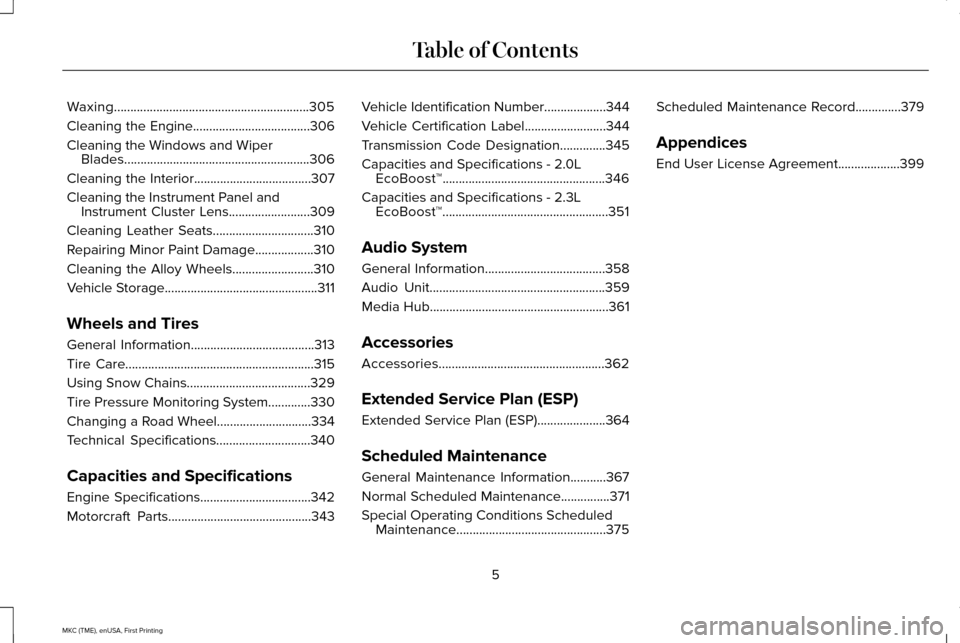
Waxing............................................................305
Cleaning the Engine....................................306
Cleaning the Windows and Wiper
Blades.........................................................306
Cleaning the Interior....................................307
Cleaning the Instrument Panel and Instrument Cluster Lens.........................309
Cleaning Leather Seats...............................310
Repairing Minor Paint Damage..................310
Cleaning the Alloy Wheels.........................310
Vehicle Storage...............................................311
Wheels and Tires
General Information......................................313
Tire Care
..........................................................315
Using Snow Chains......................................329
Tire Pressure Monitoring System.............330
Changing a Road Wheel.............................334
Technical Specifications
.............................340
Capacities and Specifications
Engine Specifications..................................342
Motorcraft Parts............................................343 Vehicle Identification Number...................344
Vehicle Certification Label.........................344
Transmission Code Designation
..............345
Capacities and Specifications -
2.0L
EcoBoost™..................................................346
Capacities and Specifications -
2.3L
EcoBoost™...................................................351
Audio System
General Information.....................................358
Audio Unit......................................................359
Media Hub.......................................................361
Accessories
Accessories...................................................362
Extended Service Plan (ESP)
Extended Service Plan (ESP).....................364
Scheduled Maintenance
General Maintenance Information
...........367
Normal Scheduled Maintenance...............371
Special Operating Conditions Scheduled Maintenance..............................................375 Scheduled Maintenance Record..............379
Appendices
End User License Agreement...................399
5
MKC (TME), enUSA, First Printing Table of Contents
Page 184 of 432
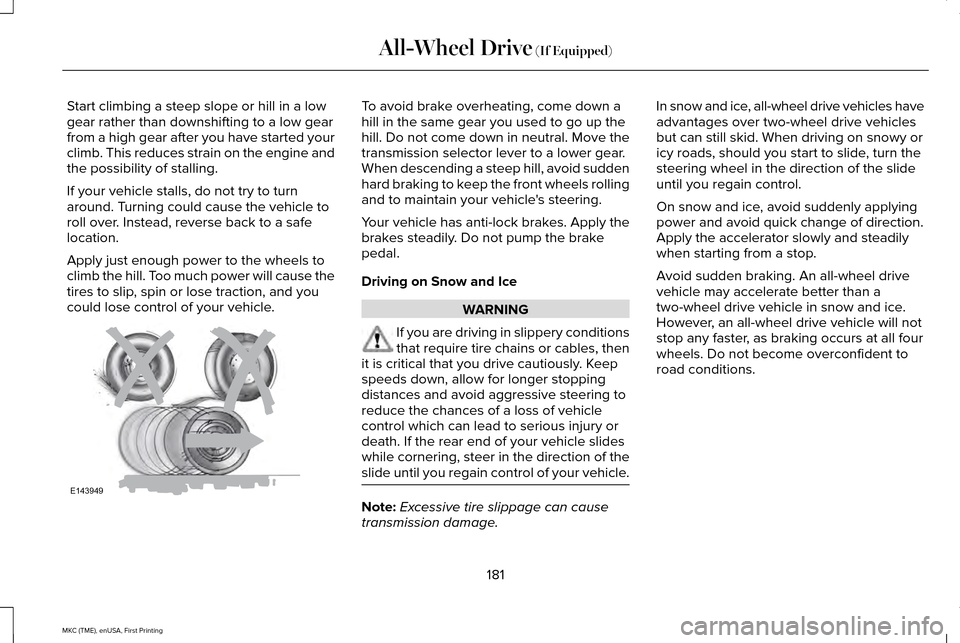
Start climbing a steep slope or hill in a low
gear rather than downshifting to a low gear
from a high gear after you have started your
climb. This reduces strain on the engine and
the possibility of stalling.
If your vehicle stalls, do not try to turn
around. Turning could cause the vehicle to
roll over. Instead, reverse back to a safe
location.
Apply just enough power to the wheels to
climb the hill. Too much power will cause the
tires to slip, spin or lose traction, and you
could lose control of your vehicle. To avoid brake overheating, come down a
hill in the same gear you used to go up the
hill. Do not come down in neutral. Move the
transmission selector lever to a lower gear.
When descending a steep hill, avoid sudden
hard braking to keep the front wheels rolling
and to maintain your vehicle's steering.
Your vehicle has anti-lock brakes. Apply the
brakes steadily. Do not pump the brake
pedal.
Driving on Snow and Ice
WARNING
If you are driving in slippery conditions
that require tire chains or cables, then
it is critical that you drive cautiously. Keep
speeds down, allow for longer stopping
distances and avoid aggressive steering to
reduce the chances of a loss of vehicle
control which can lead to serious injury or
death. If the rear end of your vehicle slides
while cornering, steer in the direction of the
slide until you regain control of your vehicle. Note:
Excessive tire slippage can cause
transmission damage. In snow and ice, all-wheel drive vehicles have
advantages over two-wheel drive vehicles
but can still skid. When driving on snowy or
icy roads, should you start to slide, turn the
steering wheel in the direction of the slide
until you regain control.
On snow and ice, avoid suddenly applying
power and avoid quick change of direction.
Apply the accelerator slowly and steadily
when starting from a stop.
Avoid sudden braking. An all-wheel drive
vehicle may accelerate better than a
two-wheel drive vehicle in snow and ice.
However, an all-wheel drive vehicle will not
stop any faster, as braking occurs at all four
wheels. Do not become overconfident to
road conditions.
181
MKC (TME), enUSA, First Printing All-Wheel Drive (If Equipped)E143949
Page 332 of 432
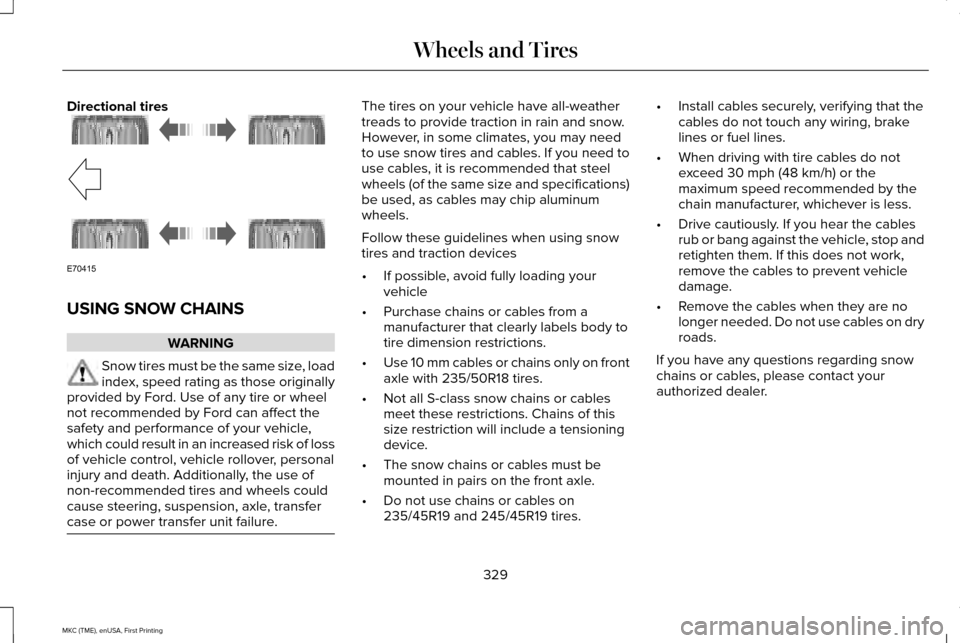
Directional tires
USING SNOW CHAINS
WARNING
Snow tires must be the same size, load
index, speed rating as those originally
provided by Ford. Use of any tire or wheel
not recommended by Ford can affect the
safety and performance of your vehicle,
which could result in an increased risk of loss
of vehicle control, vehicle rollover, personal
injury and death. Additionally, the use of
non-recommended tires and wheels could
cause steering, suspension, axle, transfer
case or power transfer unit failure. The tires on your vehicle have all-weather
treads to provide traction in rain and snow.
However, in some climates, you may need
to use snow tires and cables. If you need to
use cables, it is recommended that steel
wheels (of the same size and specifications)
be used, as cables may chip aluminum
wheels.
Follow these guidelines when using snow
tires and traction devices
•
If possible, avoid fully loading your
vehicle
• Purchase chains or cables from a
manufacturer that clearly labels body to
tire dimension restrictions.
• Use 10 mm cables or chains only on front
axle with 235/50R18 tires.
• Not all S-class snow chains or cables
meet these restrictions. Chains of this
size restriction will include a tensioning
device.
• The snow chains or cables must be
mounted in pairs on the front axle.
• Do not use chains or cables on
235/45R19 and 245/45R19 tires. •
Install cables securely, verifying that the
cables do not touch any wiring, brake
lines or fuel lines.
• When driving with tire cables do not
exceed 30 mph (48 km/h) or the
maximum speed recommended by the
chain manufacturer, whichever is less.
• Drive cautiously. If you hear the cables
rub or bang against the vehicle, stop and
retighten them. If this does not work,
remove the cables to prevent vehicle
damage.
• Remove the cables when they are no
longer needed. Do not use cables on dry
roads.
If you have any questions regarding snow
chains or cables, please contact your
authorized dealer.
329
MKC (TME), enUSA, First Printing Wheels and TiresE70415
Page 338 of 432
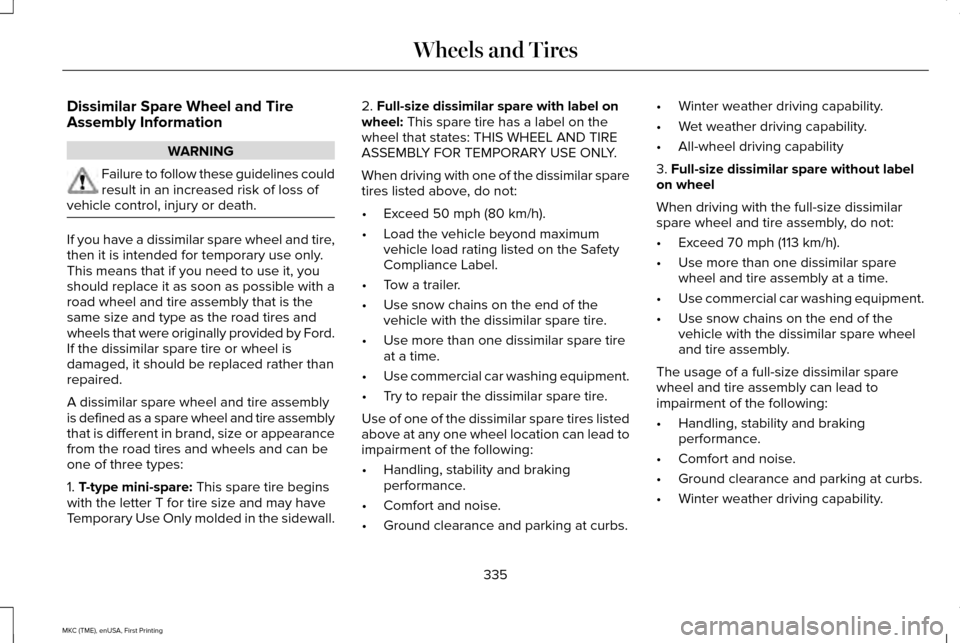
Dissimilar Spare Wheel and Tire
Assembly Information
WARNING
Failure to follow these guidelines could
result in an increased risk of loss of
vehicle control, injury or death. If you have a dissimilar spare wheel and tire,
then it is intended for temporary use only.
This means that if you need to use it, you
should replace it as soon as possible with a
road wheel and tire assembly that is the
same size and type as the road tires and
wheels that were originally provided by Ford.
If the dissimilar spare tire or wheel is
damaged, it should be replaced rather than
repaired.
A dissimilar spare wheel and tire assembly
is defined as a spare wheel and tire assembly
that is different in brand, size or appearance
from the road tires and wheels and can be
one of three types:
1. T-type mini-spare: This spare tire begins
with the letter T for tire size and may have
Temporary Use Only molded in the sidewall. 2.
Full-size dissimilar spare with label on
wheel: This spare tire has a label on the
wheel that states: THIS WHEEL AND TIRE
ASSEMBLY FOR TEMPORARY USE ONLY.
When driving with one of the dissimilar spare
tires listed above, do not:
• Exceed
50 mph (80 km/h).
• Load the vehicle beyond maximum
vehicle load rating listed on the Safety
Compliance Label.
• Tow a trailer.
• Use snow chains on the end of the
vehicle with the dissimilar spare tire.
• Use more than one dissimilar spare tire
at a time.
• Use commercial car washing equipment.
• Try to repair the dissimilar spare tire.
Use of one of the dissimilar spare tires listed
above at any one wheel location can lead to
impairment of the following:
• Handling, stability and braking
performance.
• Comfort and noise.
• Ground clearance and parking at curbs. •
Winter weather driving capability.
• Wet weather driving capability.
• All-wheel driving capability
3.
Full-size dissimilar spare without label
on wheel
When driving with the full-size dissimilar
spare wheel and tire assembly, do not:
• Exceed
70 mph (113 km/h).
• Use more than one dissimilar spare
wheel and tire assembly at a time.
• Use commercial car washing equipment.
• Use snow chains on the end of the
vehicle with the dissimilar spare wheel
and tire assembly.
The usage of a full-size dissimilar spare
wheel and tire assembly can lead to
impairment of the following:
• Handling, stability and braking
performance.
• Comfort and noise.
• Ground clearance and parking at curbs.
• Winter weather driving capability.
335
MKC (TME), enUSA, First Printing Wheels and Tires
Page 430 of 432
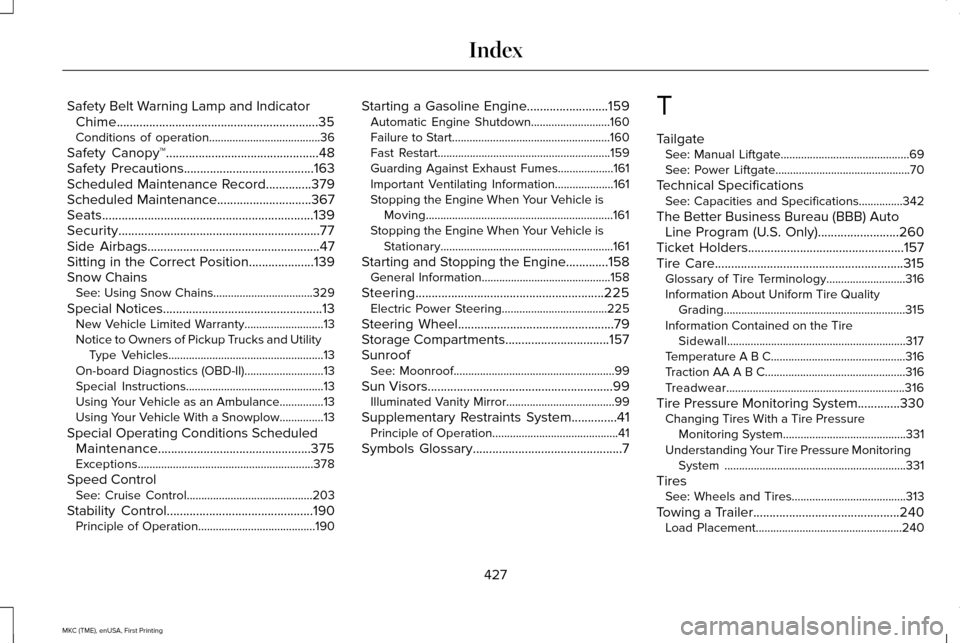
Safety Belt Warning Lamp and Indicator
Chime..............................................................35
Conditions of operation......................................36
Safety Canopy™...............................................48
Safety Precautions........................................163
Scheduled Maintenance Record..............379
Scheduled Maintenance.............................367
Seats.................................................................139
Security..............................................................77
Side Airbags.....................................................47
Sitting in the Correct Position....................139
Snow Chains See: Using Snow Chains..................................329
Special Notices
.................................................13
New Vehicle Limited Warranty...........................13
Notice to Owners of Pickup Trucks and Utility Type Vehicles.....................................................13
On-board Diagnostics (OBD-II)...........................13
Special Instructions...............................................13
Using Your Vehicle as an Ambulance...............13
Using Your Vehicle With a Snowplow...............13
Special Operating Conditions Scheduled Maintenance...............................................375
Exceptions............................................................378
Speed Control See: Cruise Control...........................................203
Stability Control
.............................................190
Principle of Operation........................................190 Starting a Gasoline Engine.........................159
Automatic Engine Shutdown...........................160
Failure to Start......................................................160
Fast Restart...........................................................159
Guarding Against Exhaust Fumes...................161
Important Ventilating Information....................161
Stopping the Engine When Your Vehicle is
Moving................................................................161
Stopping the Engine When Your Vehicle is Stationary...........................................................161
Starting and Stopping the Engine.............158 General Information............................................158
Steering..........................................................225 Electric Power Steering....................................225
Steering Wheel
................................................79
Storage Compartments................................157
Sunroof See: Moonroof.......................................................99
Sun Visors
.........................................................99
Illuminated Vanity Mirror.....................................99
Supplementary Restraints System
..............41
Principle of Operation...........................................41
Symbols Glossary
..............................................7 T
Tailgate
See: Manual Liftgate............................................69
See: Power Liftgate..............................................70
Technical Specifications See: Capacities and Specifications...............342
The Better Business Bureau (BBB) Auto Line Program (U.S. Only)
.........................260
Ticket Holders................................................157
Tire Care..........................................................315
Glossary of Tire Terminology...........................316
Information About Uniform Tire Quality
Grading..............................................................315
Information Contained on the Tire Sidewall.............................................................317
Temperature A B C..............................................316
Traction AA A B C................................................316
Treadwear.............................................................316
Tire Pressure Monitoring System.............330 Changing Tires With a Tire Pressure
Monitoring System..........................................331
Understanding Your Tire Pressure Monitoring System ..............................................................331
Tires See: Wheels and Tires.......................................313
Towing a Trailer.............................................240 Load Placement..................................................240
427
MKC (TME), enUSA, First Printing Index
Page 431 of 432
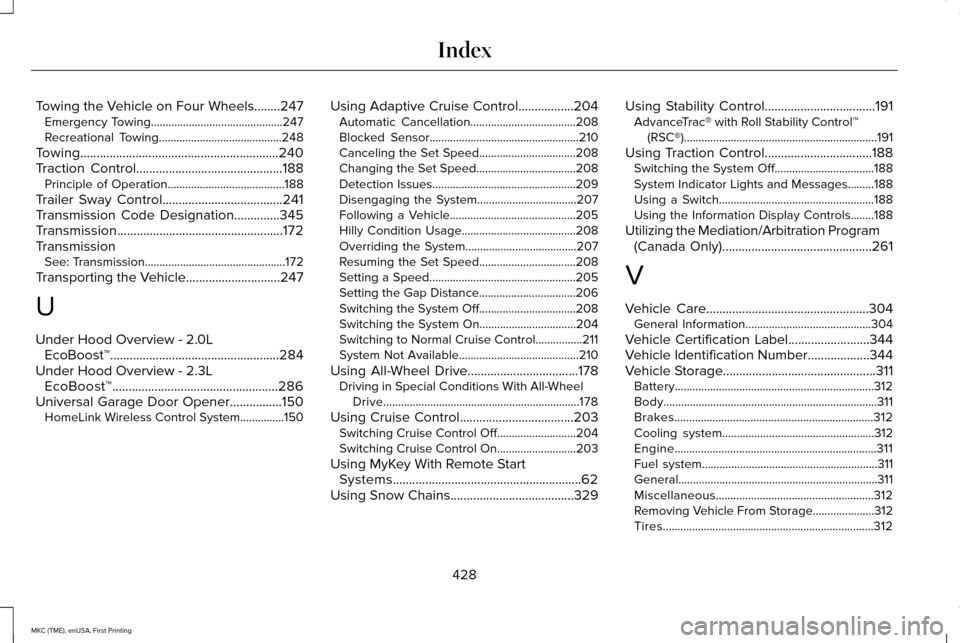
Towing the Vehicle on Four Wheels........247
Emergency Towing.............................................247
Recreational Towing..........................................248
Towing.............................................................240
Traction Control.............................................188
Principle of Operation........................................188
Trailer Sway Control.....................................241
Transmission Code Designation
..............345
Transmission...................................................172
Transmission See: Transmission................................................172
Transporting the Vehicle.............................247
U
Under Hood Overview - 2.0L EcoBoost™....................................................284
Under Hood Overview - 2.3L EcoBoost™...................................................286
Universal Garage Door Opener................150 HomeLink Wireless Control System...............150 Using Adaptive Cruise Control.................204
Automatic Cancellation....................................208
Blocked Sensor...................................................210
Canceling the Set Speed.................................208
Changing the Set Speed..................................208
Detection Issues.................................................209
Disengaging the System..................................207
Following a Vehicle...........................................205
Hilly Condition Usage.......................................208
Overriding the System......................................207
Resuming the Set Speed.................................208
Setting a Speed..................................................205
Setting the Gap Distance.................................206
Switching the System Off.................................208
Switching the System On.................................204
Switching to Normal Cruise Control................211
System Not Available.........................................210
Using All-Wheel Drive
..................................178
Driving in Special Conditions With All-Wheel
Drive...................................................................178
Using Cruise Control...................................203 Switching Cruise Control Off...........................204
Switching Cruise Control On...........................203
Using MyKey With Remote Start Systems..........................................................62
Using Snow Chains......................................329 Using Stability Control..................................191
AdvanceTrac® with Roll Stability Control™
(RSC®)..................................................................191
Using Traction Control.................................188 Switching the System Off..................................188
System Indicator Lights and Messages.........188
Using a Switch.....................................................188
Using the Information Display Controls........
188
Utilizing the Mediation/Arbitration Program (Canada Only)
..............................................261
V
Vehicle Care
..................................................304
General Information...........................................304
Vehicle Certification Label.........................344
Vehicle Identification Number...................344
Vehicle Storage
...............................................311
Battery....................................................................312
Body........................................................................\
.311
Brakes....................................................................312
Cooling system....................................................312
Engine.....................................................................311
Fuel system............................................................311
General....................................................................311
Miscellaneous......................................................312
Removing Vehicle From Storage.....................312
Tires........................................................................\
312
428
MKC (TME), enUSA, First Printing Index